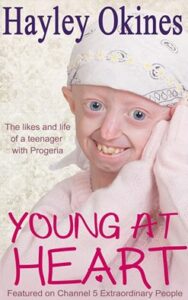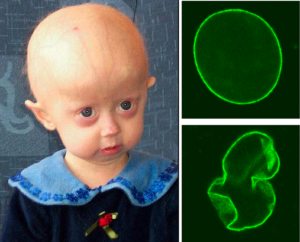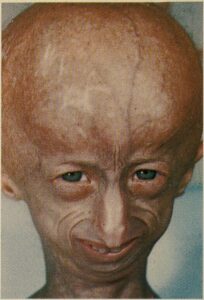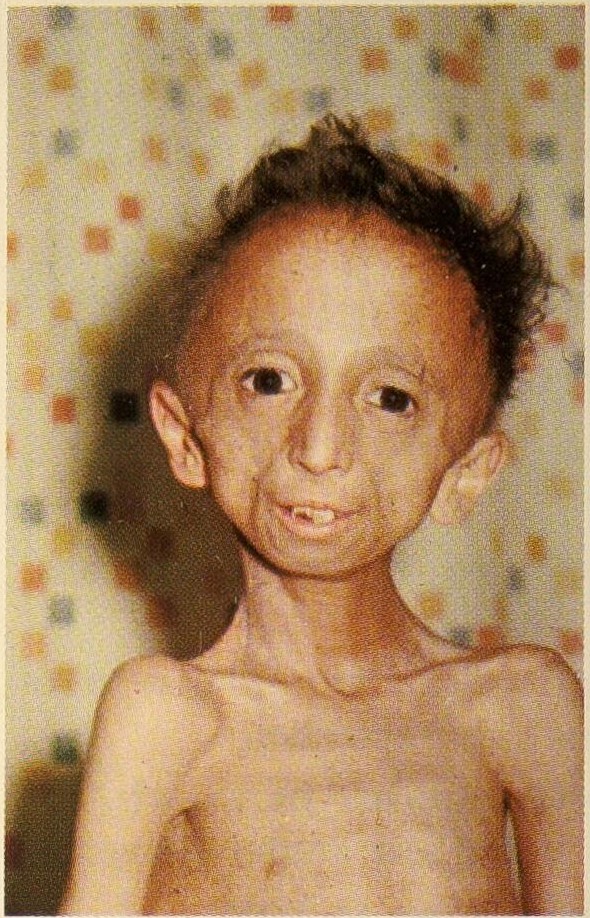
Death is a topic no one wants to think about. No one truly knows what happens after that last breath since there has not been an account of someone able to live to tell the story of their death. It is a topic that is shoved under the carpet since it is a scary thought to have at really any age. Especially for those who are young teens awaiting the day they get to have that taste of freedom once they turn eighteen. For many young teenagers, their biggest worries could range from academics, dating, social status, and even what they are going to wear for the biggest event of their high school careers – prom. However, not everyone has worries like these. Some have more severe problems that no one could ever imagine.
“It really hurts, Mum, can’t they give me something stronger,” cried out Hayley Okines, a young girl whose hip popped out in gym class not too long from that moment she laid in her hospital bed. This was the reality of her life since the day she was born. At this point in her life, she was fourteen going on one hundred-thirty-six. Okines was one of many individuals who were impacted by a progressive genetic condition known as Hutchinson-Gilford Progeria Syndrome, and this was the culprit that landed her in this crippling condition after a normal day of school.

As she got older, her body would start to slowly deteriorate as if she was already in her hundreds. Okines was in the gym when she accidentally tripped over a bench. Normally, people her age would brush themselves off and continue their day. However, for Okines who has the bones meant for a 136-year-old individual, this was detrimental. That little accident turned into a huge ordeal that led to her never being able to walk properly again due to her hip popping out of the socket. After the fall, the school called for an ambulance to take her away since she was in immense pain. Even though it was good her school reacted fast, this led to many of her classmates assuming she was dead due to her disorder.1
Okines continued to cry in pain as she held onto her younger brother’s hand. She was left to suffer until the physicians could determine what to do for her. Although she is at a healthy age with good vital signs, her bones were so fragile. Her body was too small to administer the correct dosage of anesthesia for her age group. This decision had to be made quickly since Okines’ pain was slowly worsening despite being given morphine.2
Finally, the doctors were able to determine what dosage to administer, and as the anesthesia started to make Okines sleepy, she was whisked away to the surgery room. Before she left, Okines said to her mom, “Please make sure I wake up…If I don’t wake up, Maddie’s going to come and get me.” Maddie was a friend that Okines would say she thought about whenever she was in this state of fear. Considering she was going to be in surgery under anesthesia, this truly scared her. Despite her efforts to comfort her mom, the last sight of her mother was the tears running down her face as she clutched at the door. “Maddie’s not ready for you yet, you’re coming back to Mummy. Promise me you’ll come back to Mummy.”3
Hutchinson-Gilford Progeria Syndrome is an extremely rare and deadly genetic condition that unfortunately has no cure. The main characteristic of this syndrome is the rapid aging in young individuals, and most children who are impacted by this condition die at the age of thirteen. However, there are individuals who have surpassed this age. It is important to note that this is an autosomal dominant genetic condition that is not inherited from the parents since those who are affected by this usually die before they are able to bear a child.4
About 1 in every 4 million children are affected worldwide by this, and it only takes one affected gene in someone’s DNA to give rise to this disease. It is also extremely difficult to notice if a child has progeria when they are newborns since they are already so small and fragile. However, over time, the symptoms that are noticed in individuals with this condition typically include slow growth, little to no weight gain, loss of hair, thin and wrinkly skin, dental issues, etc. These symptoms are also seen in elderly people, so those who are affected by progeria are experiencing ailments of those who are well into their 80s and older. 5
The mutation (more specifically a point mutation) that is typically seen in those with progeria is found in the LMNA gene. What this means is a single copy of a gene is mutated that occurs spontaneously during the replication of DNA. Once mutated, this will then cause a splice within exon #11 of the gene. This splice occurrence will remove roughly 150 nucleotides within someone’s DNA, and this loss results in a mutated protein, Lamin A (progerin).6

Lamin A is an important protein that aids in the scaffolding structure that keeps the nucleus together. If there is a mutation that occurs in the LMNA gene, this will then further mutate the Lamin A protein, creating a nucleus that is unstable. Due to the instability of the nuclei, this can cause early cell death within an individual’s body. This then results in the rapid aging seen in progeria.7
As we know, the nucleus is the central hub of our cells. The organizational file that stores all of our genetic information that makes us who we are. As previously stated, it is known that the mutation of the LMNA gene will cause the nucleus to become unstable. A normal nucleus is a perfect circle; however, a mutated nucleus is an awkward blob. This “awkward blob” will ultimately result in cell death, as stated previously. If a cell is in any way damaged, they will undergo this process in which they die. This is actually a bad thing. The human body sheds skin all the time. Approximately up to 40,000 cells die every day from the human skin alone. Without cell death, the skin would not be the way it is. Another way to see cell death is through aging. Cells do not stay the same age forever. Eventually, they will die off since they are no longer usable for the human body. As humans age, so do the cells. That is why it is important for healthier cells to take the place of previous cells. However, when cells die in someone who has progeria, this is not a good thing. With someone who experiences the instability of the nucleus so early on in life, their cells will die off faster and sooner. This will then create the rapid aging seen in patients impacted by progeria. The primary take-home message is one lost gene (in this case, LMNA gene) can impact the entire body immensely.8
Besides Hutcinson-Gilford Progeria, there are also other forms, which include Werner syndrome and Wiedemann-Rautenstrauch syndrome. Werner syndrome is known as progeria for adults, where symptoms can start in an individual’s teen to early adulthood years. Wiedemann-Rautenstrauch syndrome is known as neonatal progeroid syndrome where the conditions start when the individual is still in the womb. The sign of aging is more prominent at birth. Despite the drastic differences, all these conditions, including Hutchinson-Gilford Progeria, will cause premature aging.9
Usually, most surgeries help many individuals immensely after experiencing so much discomfort or pain. However, this was not the case for Okines who still had delicate bones to the point where even walking up the stairs was enough for her hip to pop out of place. Eventually, due to the number of times her hip had dislocated, she was forced to wear a metal brace for her bones to stay in one place.
“Here comes Robo-Chick,” Okines’mother would say to lighten up her spirits, however, this only painted a reminder of Okines’ situation of her progressive condition. “I don’t feel well today,” Okines would say as she woke up with legs that felt sore.10
Anyone would love to miss a day of school. To have that day of no work, no teachers, and only sleep-in is simply a dream for any student. As nice as this simple dream would be for Okines, the reason for her being at home was not due to a little cold, it was all thanks to her hip that had been terrorizing her horrendously. Ever since she started to wear the metal brace, this kept her at home for roughly a year due to her mother fearing that she might have another accident again. Thankfully, the school was understanding and allowed her to continue her education online. While she missed her friends at school, she did have a friend who would visit her. However, as days turned to weeks and weeks turned into months the feeling of missing out started to settle. Her mother never lost hope for Okines because she truly believed there was a surgery that could allow her to walk again. After months of back-and-forth meetings with their orthopedic surgeon, Eventually, he took out his little model of a hip bone and started to explain Okines’ situation. “Normally, there is a cup-shaped socket in the hip and there is a ball shape on the top of your leg bone. These fit together and are held in place with muscles and ligaments. But in your case those muscles and ligaments are so loose, they can’t hold the bones in place…” her surgeon told her. He essentially confirmed that there will be no guarantee her hip would stay in place for good.11
Okines was eventually sent to another specialist at a different hospital in London who examined her hip while asking tons of questions. As the specialist examined her, he “wiggled” her legs around as she lay on the table until her leg suddenly popped out of place. The pain was so immense for Okines, and the pain only worsened as the doctor popped it back into place. “I thought doctors were supposed to make you better, not hurt you…” sighed Okines’ mother as they left the hospital. Okines was so shaken up by this, she made her mom promise her this would never happen to her again.12
In order for a health care provider to diagnose an individual with progeria, they must pay special attention to the symptom while also providing a genetic test to confirm their suspicions. There is a physical examination conducted to determine whether a child has progeria or not. They pay close attention to height and weight, hearing and vision, blood pressure, and the more visible symptoms that show signs of aging, like dental problems, thin hair, wrinkly skin, etc.13

Some of the major complications those with progeria can potentially experience are issues with heart failure, heart attacks, their arteries being hardened, stroke due to the complications that can occur with the supply of blood vessels for the brain, etc. All of these risks are primary reasons why those impacted by this condition eventually succumb to their ailments at around the age of 15. Some individuals do live even up to the age of 20, but those with Hutchinson-Gilford Progeria are known for their short lifespans.14
After the testing and observations are done, if progeria is the determined diagnosis, there are treatments for this condition but no cure. Some treatments also include various oral medications like Lonafarnib (which helps to create proteins like progerin within cells to help decrease the ongoing progression of the condition), aspirin, etc. Lots of hospitals also highly recommend physical therapy to help individuals’ joints. Essentially, any care given or seen in elderly patients is given to children impacted by progeria. Despite the limited treatment, there is still ongoing research and tests to find new medications that can help those with progeria lead a longer life span. There is also immense research being done to see how healthcare officials can prevent various diseases, such as heart disease, from occurring in these patients since this is one of the more common reasons why those with progeria pass away so soon. With these various ailments that impact the body such as the cardiovascular or digestive system, a child who could be 14 years old is living through the body of someone in their late eighties. There are also lots of studies being conducted on genes to help us gain a better understanding of how the gene affected by the Lamin A mutation occurs and how it impacts the body. There are also home remedies that can be implemented into someone’s life in order to help reduce the risks of various ailments and diseases from occurring such as drinking lots of water, eating more nutritious meals, using plenty of sunscreen, etc.15
“As you can see, your hips are set at an angle and the sockets are shallow,” the doctor stated, “As a result, they can’t hold the bone in place…There is an operation we can do but it would mean cutting the top of your femur or thigh bone to realign it. Although the idea of finally being about to walk again was enticing for Okines, this still brought lots of worry to her mother. “What are the risks?” Okines mom asked. “For someone like Hayley, there is a greater risk than a normal person…” the doctor said. This was because although Okines was almost an adult, her body was that of a child. There was also a risk of her skin forming an infection due to how fragile she was.16
There was then that fateful question no one wants to ever think about. “Is there a chance she won’t wake up after the operation?” Okine’s mother asked. “Hayley’s heart is strong, she is healthy, her blood pressure is normal, but with all the surgery there is always a risk,” the doctor replies. There was only about a thirty percent chance of Okines ever walking again, so the odds of this surgery being successful were slim. Ultimately, after weighing the pros and cons of what to do, the final decision was to simply move on in life without the surgery. With the high chances of complications and infections, this was not worth it for them.17
“If only the odds of you being able to walk again were fifty-fifty it would be better,” Okines’ mom sighed as the disappointment started to settle in.
According to the Progeria Research Foundation, there are continuous clinical trials that are geared towards those with progeria. There was a trial done with two drugs called Lonafarnib and Rapamycin. Phase one of the trial aimed to find a safe dosage of Rapamycin, which was ongoing from April 2016 to June 2017. From there, researchers continued to phase 2 in July of 2017 to test how effective these drugs were when combined. This then concluded in April of 2022, and, fortunately, about sixty children from various countries partook in this clinical trial. What researchers noticed about rapamycin was the fact that there wasn’t a need for lots of blood drawn to measure the levels of the drug. These trials soon proved that combining drugs such as Lonafarnib (a Farnesyltransferase inhibitor) and Rapamycin can create this effect known as a “one-two punch” to decrease the severity of progeria. One important note to keep in mind is that Lonafarnib was already proven to treat Progeria, but is there more that can help increase the lifespan? Again, this is still an ongoing and extremely hopeful clinical trial still occurring.
Rapamycin was a drug approved by the FDA that showed signs of preventing aging in mice. With this knowledge in mind, scientists started to see how this can connect to humans and ultimately help those with progeria lead a longer lifetime. After analyzing results, researchers at the National Institute of Health in Bethesda, Maryland were able to determine that Rapamycin was able to lessen the numbers of the mutation progerin protein by about 50%. This showed extremely promising outcomes for the future of those with progeria.18
Overall, the main purpose of the clinical trials discussed by the Progeria Research Foundation is to see what medication or combination of medications will help to lengthen the lifespan of an individual with Progeria. The research organization dove into more details concerning the various trials take took place. From only utilizing one drug (lonafarnib) in 2006 to combining this one drug with two more later on in 2009, this research showed immense promise for those wanting more time with their loved ones. It is important to note that in the 2009 trial that involved lonafarnib, zoledronate, and pravastatin, the protocol was changed throughout that five-year period. This was primarily to allow more children to become participants in the clinical trials. Although there was not a lot of information given about the survival rate or measurements that were taken, this study alone was able to prove that with these treatments of various medications, there are significant results in patients with progeria improving.
Despite having a genetic condition that progressively deteriorated her body, Okines never let her ailments overcome her will to live. She still had hope and aspirations like other individuals in society who dreamed of fulfilling their life’s purpose. She had that want to learn how to drive, get a house of her own, that want of leaving home and moving off to New York to start her own beauty salon.
Individuals like Okines are proof that no matter what obstacles one might face, whether it be physical or mental, it is extremely important to never take time for granted. Yes, there are still so many unknowns in the world of genetics. We still have so many questions and wonders about how certain diseases, conditions, or ailments come to be. However, this unknown never put Okines down. She still had the biggest aspirations anyone could ever imagine. At the end of her book, Young at Heart, she included her bucket list of things she wanted to do in her lifetime such as stargazing, meeting a turtle, going ghost hunting, and even going to Las Vegas. This simply just comes to show even those who have a short lifespan can have some of the biggest dreams.
Now, if there is one thing someone should take away from a story like Okines, it’s to never let an obstacle stop you from living your life to the fullest. Although her life was cut short at the age of seventeen, she still had accomplished so much in life to show society that even though she was aging faster than the normal rate, she still found this motivation to accomplish so much in life. Of course, this article does not want to make someone think about their inevitable death, but it is to emphasize that what we do in our lifetime will depict who we are. Whether we live to be one hundred or only up to the age of seventeen, no one should ever take time for granted.
- Okines, H. (2014). Young at heart: The likes and life of a teenager with progeria. Abercynon, Wales : Accent Press. http://archive.org/details/youngatheartlike0000okin(19-23). ↵
- Okines, H. (2014). Young at heart: The likes and life of a teenager with progeria. Abercynon, Wales : Accent Press. http://archive.org/details/youngatheartlike0000okin (19-23). ↵
- Okines, H. (2014). Young at heart: The likes and life of a teenager with progeria. Abercynon, Wales : Accent Press. http://archive.org/details/youngatheartlike0000okin (19-23). ↵
- About Progeria. (n.d.-a). The Progeria Research Foundation. Retrieved October 8, 2023, from https://www.progeriaresearch.org/about-progeria/. ↵
- Progeria (Hutchinson-Gilford Progeria Syndrome — HGPS): Symptoms & Causes. (n.d.). Cleveland Clinic. Retrieved October 8, 2023, from https://my.clevelandclinic.org/health/diseases/17850-progeria. ↵
- Progeria (Hutchinson-Gilford Progeria Syndrome — HGPS): Symptoms & Causes. (n.d.). Cleveland Clinic. Retrieved October 8, 2023, from https://my.clevelandclinic.org/health/diseases/17850-progeria. ↵
- Progeria (Hutchinson-Gilford Progeria Syndrome — HGPS): Symptoms & Causes. (n.d.). Cleveland Clinic. Retrieved October 8, 2023, from https://my.clevelandclinic.org/health/diseases/17850-progeria. ↵
- Cell Death: Types, Causes & Necrosis. (n.d.). Cleveland Clinic. Retrieved October 29, 2023, from https://my.clevelandclinic.org/health/articles/cell-death. ↵
- Progeria—Symptoms and causes—Mayo Clinic. (n.d.). Retrieved October 8, 2023, from https://www.mayoclinic.org/diseases-conditions/progeria/symptoms-causes/syc-20356038 ↵
- Okines, H. (2014). Young at heart: The likes and life of a teenager with progeria. Abercynon, Wales : Accent Press. http://archive.org/details/youngatheartlike0000okin (19-23). ↵
- Okines, H. (2014). Young at heart: The likes and life of a teenager with progeria. Abercynon, Wales : Accent Press. http://archive.org/details/youngatheartlike0000okin (19-23). ↵
- Okines, H. (2014). Young at heart: The likes and life of a teenager with progeria. Abercynon, Wales : Accent Press. http://archive.org/details/youngatheartlike0000okin (19-23). ↵
- Progeria—Diagnosis and treatment—Mayo Clinic. (n.d.). Retrieved October 8, 2023, from https://www.mayoclinic.org/diseases-conditions/progeria/diagnosis-treatment/drc-20356043 ↵
- Progeria—Symptoms and causes—Mayo Clinic. (n.d.). Retrieved October 8, 2023, from https://www.mayoclinic.org/diseases-conditions/progeria/symptoms-causes/syc-20356038 ↵
- Progeria—Diagnosis and treatment—Mayo Clinic. (n.d.). Retrieved October 8, 2023, from https://www.mayoclinic.org/diseases-conditions/progeria/diagnosis-treatment/drc-20356043 ↵
- Okines, H. (2014). Young at heart: The likes and life of a teenager with progeria. Abercynon, Wales : Accent Press. http://archive.org/details/youngatheartlike0000okin (19-23). ↵
- Okines, H. (2014). Young at heart: The likes and life of a teenager with progeria. Abercynon, Wales : Accent Press. http://archive.org/details/youngatheartlike0000okin (19-23). ↵
- Clinical trials. (n.d.). The Progeria Research Foundation. Retrieved October 8, 2023, from https://www.progeriaresearch.org/clinical-trials/ ↵




2 comments
Dylan Vargas
It was so fascinating and sad to read about the difficult truth of everyday life with Hutchinson-Gilford Progeria Syndrome. Though the article dives deep into Hayley Okines life with this Syndrome but also carefully explains the syndrome in a very informative form. Explaining things about how mutation of the LMNA gene can cause this syndrome and how exon #11 of the gene is spliced, going into details while explaining a hurtful but truthful story makes this article so compelling, I can see how it was able to win an award.
Johana Solís
Hi Franchesca! This article was well informative about Hutchinson-Gilford Prgeria Syndrome. I had no idea this syndrome even existed. If you haven’t had included Hayley Okines story I would probably had no idea what this syndrome is.